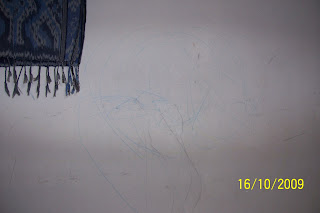More info on Dyslexia
What does a dyslexic person see when she reads? (source from :http://www.dyslexia.com)
There is no single pattern of difficulty that affects all dyslexic people. A dyslexic person might have any of the following problems:
* She might see some letters as backwards or upside down;
* She might see text appearing to jump around on a page;
* She might not be able to tell the difference between letters that look similar in shape such as o and e and c ;
* She might not be able to tell the difference between letters that have similar shape but different orientation, such as b and p and d and q ;
* The letters might look all jumbled up and out of order;
* The letters and words might look all bunched together;
* The letters of some words might appear completely backwards, such as the word bird looking like drib ;
* The letters and words might look o.k., but the dyslexic person might get a severe headache or feel sick to her stomach every time she tries to read;
* She might see the letters o.k., but not be able to sound out words -- that is, not be able to connect the letters to the sounds they make and understand them;
* She might be able to connect the letters and sound out words, but not recognize words she has seen before, no matter how many times she has seen them -- each time she would have to start fresh;
* She might be able to read the words o.k. but not be able to make sense of or remember what she reads, so that she finds herself coming back to read the same passage over and over again.
A dyslexic person could have any of the above symptoms -- or none ! It is possible for a dyslexic person to be able to read very well, yet find it extremely difficult or impossible to write or spell . Sometimes the writing problem is called 'dysgraphia' instead of 'dyslexia' - but we find that often these symptoms stem from the same underlying causes as dyslexia.
It is important to understand that when a dyslexic person *sees* letters or words reversed or mixed up, there is usually nothing wrong with her eyes. The problem is in the way the mind interprets what the eyes see -- like an optical illusion, except this mismatch between what illusion and reality happens with ordinary print on a page.
There is no single pattern of difficulty that affects all dyslexic people. A dyslexic person might have any of the following problems:
* She might see some letters as backwards or upside down;
* She might see text appearing to jump around on a page;
* She might not be able to tell the difference between letters that look similar in shape such as o and e and c ;
* She might not be able to tell the difference between letters that have similar shape but different orientation, such as b and p and d and q ;
* The letters might look all jumbled up and out of order;
* The letters and words might look all bunched together;
* The letters of some words might appear completely backwards, such as the word bird looking like drib ;
* The letters and words might look o.k., but the dyslexic person might get a severe headache or feel sick to her stomach every time she tries to read;
* She might see the letters o.k., but not be able to sound out words -- that is, not be able to connect the letters to the sounds they make and understand them;
* She might be able to connect the letters and sound out words, but not recognize words she has seen before, no matter how many times she has seen them -- each time she would have to start fresh;
* She might be able to read the words o.k. but not be able to make sense of or remember what she reads, so that she finds herself coming back to read the same passage over and over again.
A dyslexic person could have any of the above symptoms -- or none ! It is possible for a dyslexic person to be able to read very well, yet find it extremely difficult or impossible to write or spell . Sometimes the writing problem is called 'dysgraphia' instead of 'dyslexia' - but we find that often these symptoms stem from the same underlying causes as dyslexia.
It is important to understand that when a dyslexic person *sees* letters or words reversed or mixed up, there is usually nothing wrong with her eyes. The problem is in the way the mind interprets what the eyes see -- like an optical illusion, except this mismatch between what illusion and reality happens with ordinary print on a page.











